Developers and marketers use notification systems to communicate with and engage app users, but these systems come in various forms. Some opt for commercial notification systems that offer a set of features and capabilities for a fee. Those who want more control over their notification system might opt for open source notification tools. Supporting an open source project can involve contributing code, documentation, or even financial support.
Open source notification tools offer various features and services that developers can leverage to build a custom notification system for their applications. With access to the source code, developers have more control, and they also benefit from lower costs. An open source notification platform can simplify complex multi channel delivery by consolidating multiple communication channels into a single, unified inbox for users, making it easier to manage notifications across different platforms.
The open source community plays a crucial role in contributing to and maintaining these projects, as seen by the number of GitHub stars and contributors. By joining the open source community, developers can collaborate, share knowledge, and help improve these tools for everyone.
However, setting up all the moving parts of a notification system is cumbersome. Whether you choose open source or a managed solution, understanding scalable notification system design principles is essential for building reliable, production-ready systems. MagicBell offers a complete notification system with a React SDK, and it can be used for up to 1,000 deliveries per month for free, making it an ideal solution for businesses evaluating push notification system options. With MagicBell, you can have a complete notification system up and running in less than an hour to notify users wherever they are and how they prefer. With various notification APIs, you can fully customize MagicBell to suit your needs. Some solutions, like MagicBell, are designed for complex multi channel delivery, consolidating multiple communication channels into a single, developer-friendly component.
If you’re interested in exploring more open source notification tools, we’ve rounded up 40 of the most useful open source notification systems and tools below. Note that the open source notification tools below are listed in alphabetical order; otherwise, they’re not ranked or rated in any way.
Introduction to Notification Systems
Notification systems are essential tools for keeping users informed and engaged across a wide range of platforms and services. At their core, these systems are designed to send notifications—such as push notifications, web push notifications, and SMS—to users through various channels. A typical notification system consists of a notification server, which manages the sending and receiving of notifications, and a client application that displays these notifications to the user. As modern products increasingly rely on real-time communication, notification systems have become a critical component for developers looking to notify users about important events, alerts, and updates. Whether integrated into a web app, mobile app, or other digital platforms, notification systems help ensure that users receive timely and relevant information, enhancing the overall user experience and engagement.
Features of Notification Systems
Modern notification systems are packed with features that empower developers to deliver the right message to the right user at the right time. One of the standout capabilities is support for multiple channels, allowing notifications to be sent via push notifications, email, SMS, and more. This multi-channel approach ensures users can receive messages on their preferred device or platform. Custom notifications are another key feature, enabling developers to tailor messages with specific content, images, and actions to maximize user engagement. Many notification systems also incorporate message queues, which help manage and prioritize the flow of notifications, ensuring that important messages are delivered promptly. Advanced systems may include a digest engine to aggregate multiple notifications into a single, concise message, reducing notification fatigue. Additionally, robust tracking and analytics features provide valuable insights into notification performance, helping developers optimize their communication strategies and better support their users.
1. AeroGear
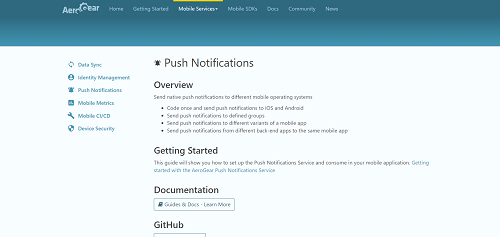
AeroGear is an open-source and cloud-native mobile application development platform. AeroGear is an open source project with an active open source community contributing to its ongoing development and support. It has a wide range of applications including one for push notifications and can be used to send push notifications to iOS and Android devices. It supports segmentation and sending targeted messages to categorized groups and also supports various backend applications for the same mobile app. The source code is available as a GitHub repository.
2. AirNotifier

AirNotifier is an open-source solution to send notifications across platforms like Android, iPhone, iPad and desktop browsers. The service has features including API, admin UI, access token, logging, etc. AirNotifier serves as a notification platform for developers to manage and deliver notifications across devices. You can integrate the service within your application without incurring any cost and you only need to contact the makers of the service if you need a hosted solution for your push notifications.
3. Apache RocketMQ
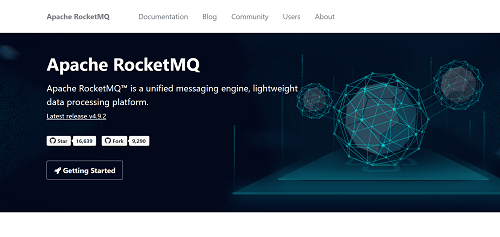
Apache RocketMQ is a unified messaging engine designed to send and receive messages, with more than a 99.6% response latency within 1 millisecond under high pressure. It has a wide range of tracking and audit features making it suitable for all vendors and is a lightweight data processing platform making it big data-friendly. It is available to download at GitHub.
4. APNS2
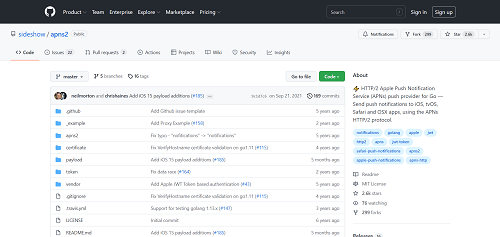
An APNS push notification provider for Go, push notifications are executed via the HTTP/2 protocol. The system supports iOS, OSX, and Safari and an added advantage is the support for the latest Apple Token Based Authentication (JWT). It has been proven reliable in production environments and is used by many Apple developers.
5. Chanify
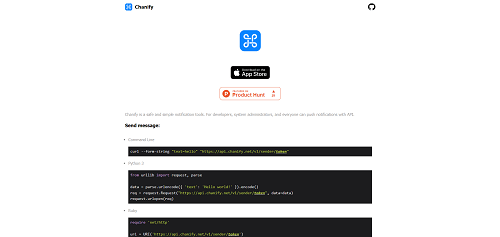
Chanify is a simple and safe notification tool. The system allows developers and system administrators to send push notifications from the command line, Python, Ruby, or Node.js with the command line tools available open-source on GitHub. It also has an iOS app that can be used to send push notifications and is a featured product on Product Hunt.
6. Django Push Notifications
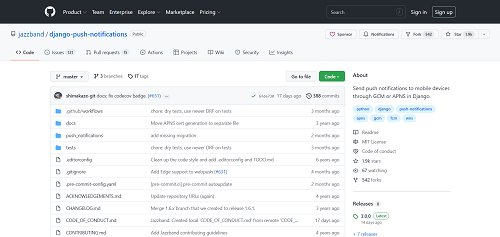
Django is a popular web framework among developers. An open-source app available on GitHub, this app implements device models that can send push messages through APNS, FCM/GCM, WNS and WebPush. It also has an elaborate admin panel that can be used to test single and bulk notifications. It works on Python 3.6+ and Django 2.2+.
7. Django Pushy
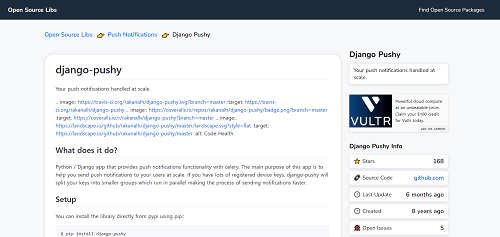
An open-source Django app for push notifications, the push notification functionality is implemented with Celery. The main use case for Django pushy is to send notifications at scale. The library splits the large number of device tokens into smaller groups and runs push services in parallel.
8. FP-QUI

FP-QUI is a dedicated tool to send push notifications to Windows devices. It can be customized according to your needs and integrates easily with existing programs without any need for specific add-ins. FP-QUI can also be run from the command line.
9. Gaurun
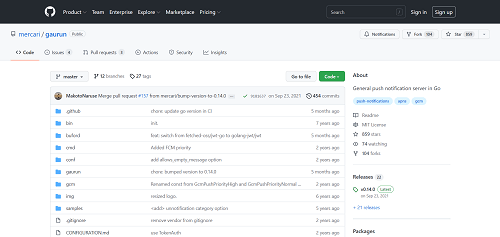
Gaurun is a general push notification server written in Golang. It proxies push requests to APNS and FCM and also asynchronously executes push notifications using HTTP/2. It is used to send bulk push notifications on the scale of tens of millions, made possible by the powerful concurrent feature available with Golang. It is available open-source as a GitHub repository.
10. Gotify
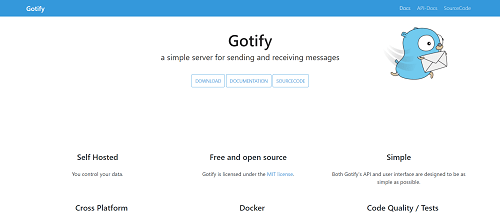
Gotify is a push notification service you can host on your own servers. Gotify is built using multiple programming languages like Go, Java, and JavaScript for a more efficient system that uses the most suitable language for each part. Code analyzers and test suites are also built into the system. The service is available open-source and can be downloaded from GitHub.
11. Gorush

Gorush is a push notification micro-server built using the Gin framework. The library is written in Go (Golang) and it supports APNS, FCM, and HMS. The application can be stored in the memory of most popular database systems and it has added support for Prometheus monitoring systems.
12. Growl
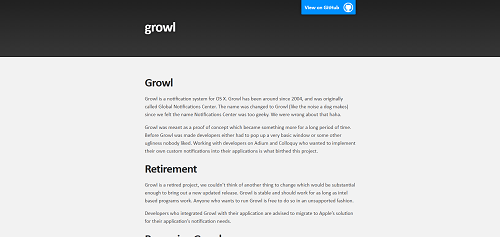
Growl is a notification system exclusively for OSX. The library has been in service since 2004 and was originally known as the Global Notifications Center. It helps to create custom notifications for OSX applications and is available to download on GitHub.
13. Iris
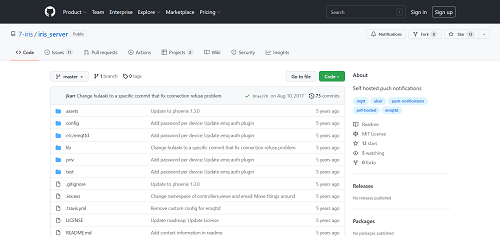
Iris is a self-hosted notification server solution. Iris can work without Firebase cloud messaging (FCM) or Apple push notification service (APNS) and can send transactional notifications based on preset triggers. To get started with Iris you'll need to install the emqttd server.
14. .NET Core Push Notifications
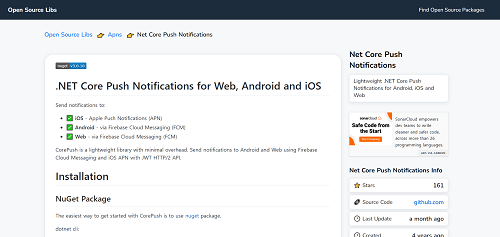
A library to implement Android and Web using Firebase Cloud Messaging, .NET also supports iOS APNS with JWT HTTP/2 API. It works with the Nuget package manager for the .NET framework and is a lightweight library with minimal overheads. The downside is that you have to use FCM for Android and Web notifications.
15. Node Push Notifications
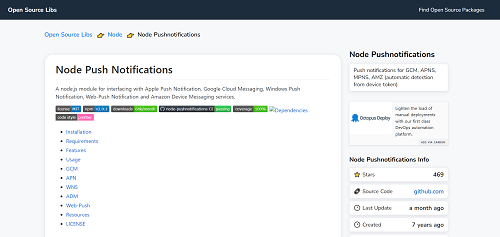
A node.js module that integrates various push notification standards such as APNS, FCM, Windows Push Notification, etc. The library automatically detects destination devices and routes push notifications accordingly. It also supports unified error handling and can be installed directly with npm.
16. Notica
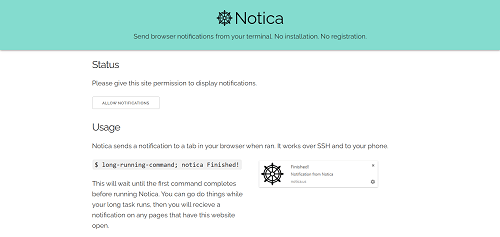
Notica is a notification library to send browser push notifications that allows you to send push notifications to both desktop and mobile browsers from the terminal. It also works over an SSH connection. Curl is required to set up and use Notica.
17. Notif.me
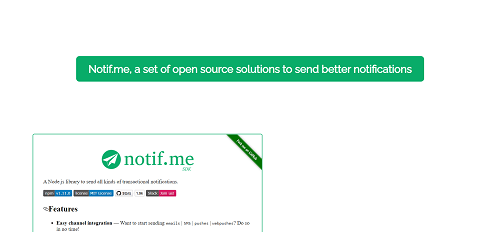
Notif.me is a Node.js library used to send transactional notifications through multiple channels, such as email, SMS, and push notifications. It supports complex multi channel delivery, allowing developers to consolidate multiple communication channels into a single workflow. The library also has extensive documentation making it easy for developers to set up the system and allowing for a lot of flexibility and customization options for users.
18. Notifier
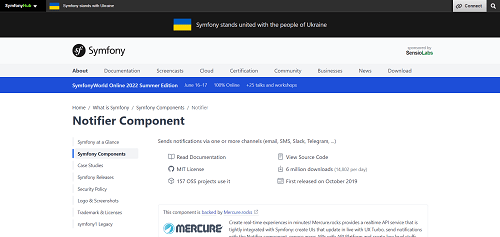
Notifier is an application component that enables you to send notifications through multiple channels, with email, SMS, Slack, Telegram and push all being supported. It serves as a notification platform that simplifies multi-channel messaging for developers by unifying notifications into a single, developer-friendly solution. The source code is available with an MIT license as a GitHub repository, can be easily installed using composer and integrated with any php project.
19. Notifire
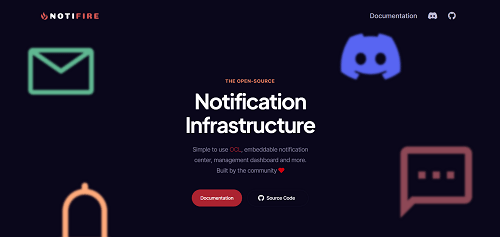
Notifire is an open-source notification infrastructure. It has a simple outgoing communication layer, embeddable notification center, and management dashboard. The notification center provides a unified inbox for users to manage notifications from multiple channels. Notifire is a notification platform built for developers, simplifying multi-channel messaging into a single interface. The Novu API powers Notifire's backend, handling triggers, queues, and message dispatching through various providers. There’s also a community that adds support to more and more notification service providers. The source code is available to download and use on GitHub.
20. Notifo
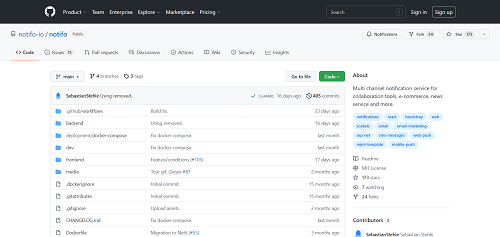
Notifo is a notification service for collaboration tools, e-commerce platforms, and news services. It supports multiple platforms like emails, web push, mobile push, and SMS and has a reliable retry mechanism. It also manages message queues efficiently across different notifications and channels. Notifo provides a central inbox for users to manage notifications across different channels.
21. NOTY
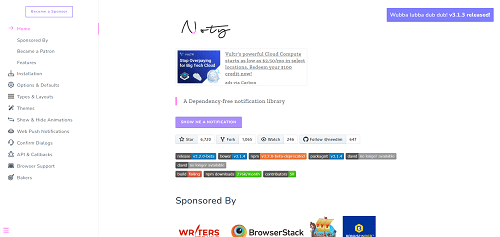
A complete notification library that has no dependencies, it has a named queue system that makes sending notifications easy, even at scale. It supports various existing CSS projects and custom templating. NOTY also allows users to set their notification preferences for a more personalized experience, and it’s available on GitHub under an open-source license.
22. Parse
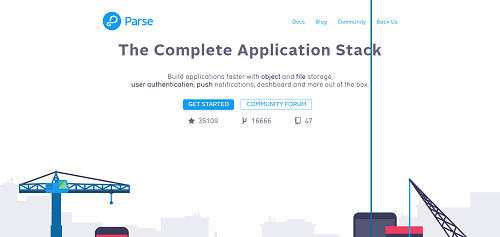
It is a complete application stack that has native support for push notifications. The advantage of using it is that there’s no need to bandage multiple services for your application. Object and file storage, user authentication, and dashboards are other built-in features of the stack. Parse enables secure account verification and login procedures for users, helping to prevent fraud and unauthorized access. Users can log into their accounts securely and manage their notification preferences for a customized experience. The source code is available open-source as a GitHub repo.
23. Pigeon
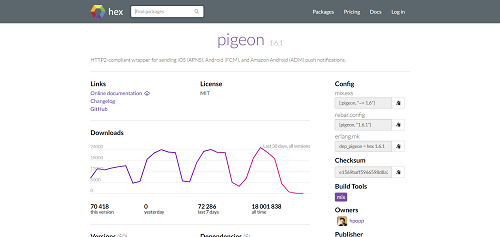
Pigeon is a push notification system for the Erlang ecosystem. It is an HTTP2-compliant wrapper for APNS, FCM, and Amazon Android (ADM) push notifications. It supports advanced use-cases with dynamic dispatchers and is available as a GitHub repository.
24. Pushd
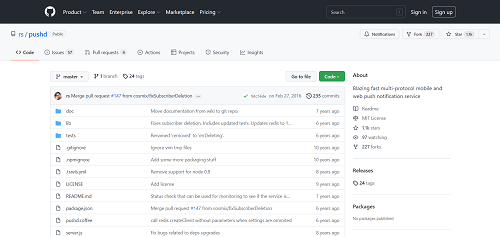
Pushd is a fast mobile and web push notification service. It works with multiple protocols giving a high degree of freedom for developers. The library handles the internal dynamics of different platforms to which push notifications are to be delivered. It supports APNS, FCM, MPNS, HTTP POST, EventSource, and WNS (Windows Notification Service).
Pushd efficiently processes notification delivery requests by parsing, validating, and routing each request across multiple channels to ensure reliable and automated notification delivery.
25. PushJs
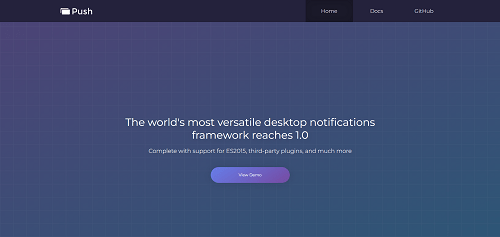
PushJs is a versatile platform for Javascript desktop push notifications. It supports ES2015 and third-party plugins and has a notification API to reach modern desktop browsers, including Chrome, Safari, Firefox, and Edge. The library can be installed with npm added to your project.
PushJS can also be used to build a notification inbox for desktop users, providing a central interface to manage notifications across multiple channels.
26. Pushbits
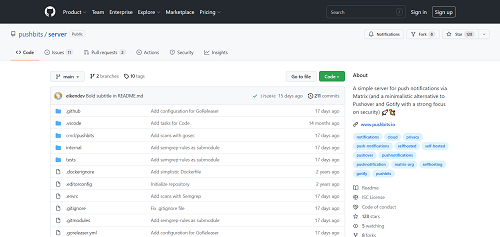
Pushbits is a push notification server created via Matrix with a focus on strong security. It supports multiple users and multiple channels per user and allows API and CLI to manage users and subscriptions. Pushbits also provides secure account management features, including user account verification and login procedures, to protect user data and prevent unauthorized access. It also integrates HIBP to detect weak passwords.
27. Pushkin

Pushkin is a notification tool built with speed and fast experimentation in mind. It supports Android and iOS applications and was developed primarily for mobile games, but can be used for any application. It is designed as a responsive tool to react to your game server, database server, or client.
28. Pushkit
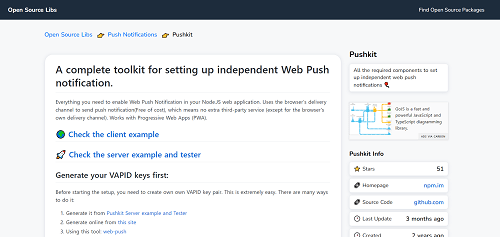
Pushkit is an open-source library that helps to enable web push notifications in your Node.JS web application. The library uses browsers as the delivery channel to send push notifications and it can be set up as a standalone application without the support of other notification services. It also works with Progressive Web Apps (PWA).
29. PushServer
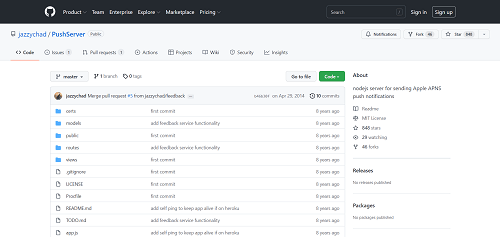
PushServer is a NodeJS server for sending Apple APNS push notifications. The server is set up to run on Heroku but can also be run locally. It uses MongoDB to store device token information and subscribed channel lists, plus it has an intuitive API and a convenient dashboard. PushServer can also log notification delivery and user authentication events for auditing purposes.
30. Pushy

Pushy is a library to integrate push notifications to a Swift iOS client. Push notifications are implemented with Apple Push Notification Server (APNS), which helps to simplify push notification implementation for iOS. The iOS client can be compiled on your device using Xcode and the developer has also created an application to support it.
31. Pushy Console
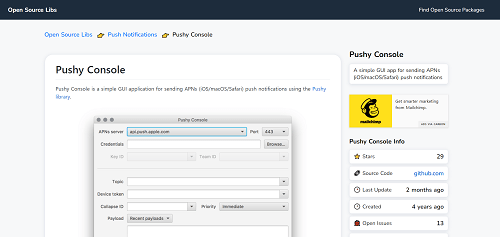
Pushy Console is an extension built on top of the Pushy library mentioned above. It is a graphical user interface to send APN (iOS/macOS/Safari) push notifications and can be used to send a single notification to a device. It is intended to be a tool for testing push notification functionality for developers using Pushy. When a notification is sent, Pushy Console processes the received data to display notification delivery results, allowing developers to verify how incoming notifications are handled. The source code is available to download on GitHub.
32. PyFCM

A Python client for FCM, PyFCM can be installed directly from PyPi with pip. The library supports Android, iOS and Web notifications and also has a version specific to Django on GitHub.
33. rPush
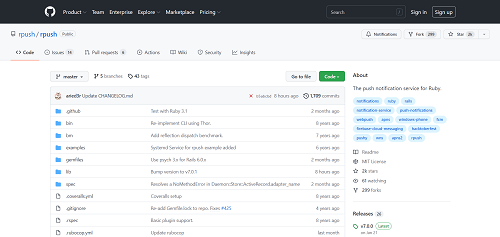
A Ruby gem that sends push notifications. Easy to use, reliable and rich in features, it is designed to give greater control, even for large projects. It integrates APNS, FCM, Windows push, Webpush, and Amazon device messaging. rPush processes received data by validating incoming notification events, managing the flow from trigger to delivery, and updating notification status accordingly.
34. Ruby Push Notifications
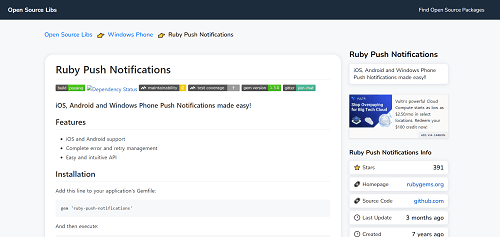
A Ruby gem that supports iOS, Android and Windows push notifications, it has an easy-to-use and intuitive API that makes life easier for developers. It also has complete error and retry management systems. Additionally, Ruby Push Notifications can log notification delivery attempts and errors, making troubleshooting more efficient.
35. Simple Web Notification
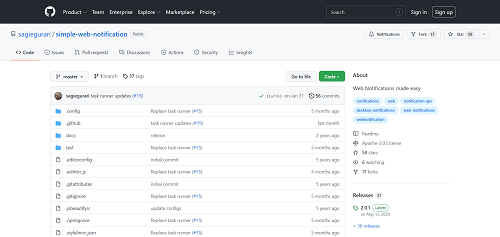
To integrate web push notifications with your application, you need to build it for the different browsers on the market. Simple Web Notification is a library that integrates notification systems for various browsers. It has a notifications API with automatic permissions support. Additionally, Simple Web Notification allows users to set their notification preferences for different browsers. The library does not have any external dependencies, but the browser must support notification API or have Polyfill.
36. Snarl

Snarl is an application platform to control notifications of different applications. It intends to unify the applications which generate notifications with the services that consume them, allowing users to dictate when and how to receive notifications on their devices. Snarl also enables users to customize their notification preferences for each application. Snarl is a basic platform and developers can modify it according to their creativity and needs. It is available to download with an open-source license on GitHub.
37. Thunderpush

An open-source library to set up a notification server, Thunderpush is used exclusively to send browser push notifications in real-time. Thunderpush can also be integrated with chat applications to deliver instant notifications to users, enhancing real-time communication. A push service based on Tornado and SockJS, Thunderpush has Python and JavaScript clients and is available as HTTP API and client.
38. UnifiedPush
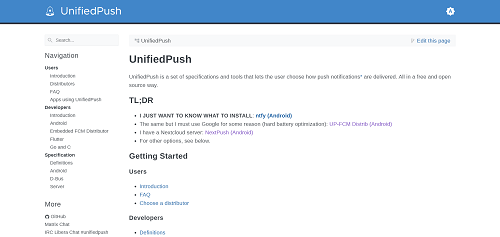
UnifiedPush is an open standard to receive push notifications and supports multiple implementations and servers. You can use the service in multiple ways:
- Self-host the server
- ntfy
- NextPush
- Gotify
- Other options
- FCM-Distributor
- NoProvider2Push
The core UnifiedPush tools are open source and available for free download on GitHub.
UnifiedPush is supported by an active open source community, with contributors collaborating on GitHub and other platforms to improve and maintain the project.
39. Uniqush

Uniqush is free software to create push notifications for all mobile devices. It is a standalone server program that you can host on your own server with a simple and unified interface server developers can access. The code repositories are available to download at GitHub. If you find Uniqush useful, consider supporting the open source project by contributing code or making a donation to help its ongoing development.
40. Web Push PHP
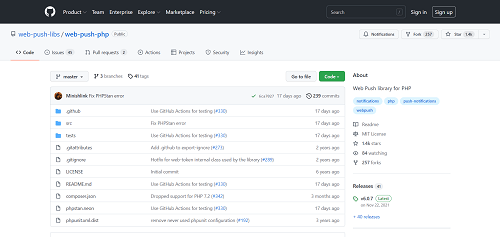
A PHP library that’s used to send web push notifications, Web Push PHP is useful for a large number of web applications. It works across all server types, making it a reliable app for PHP websites such as WordPress. With 40% of all websites built on that platform, web push PHP has become a popular choice among developers.
While there are many open source notification systems you can use to manage and execute push notification campaigns, MagicBell makes it easier with a complete notification system you can have up and running within an hour. With MagicBell, you can notify users wherever they are (push, email, in-app) and how they prefer (smart delivery, batching, etc.) without sending the same user the same notification twice. MagicBell and similar solutions provide complex multi channel delivery as part of their notification platform, consolidating multiple communication channels into a single, developer-friendly component built on open source technology.
When building a comprehensive notification system, it's essential to understand the strengths of each channel. Push notifications excel at real-time engagement and immediate alerts, but they should be complemented with email for transaction-critical information. Our transactional email guide covers how transactional emails achieve 70-90% open rates and provide users with permanent records of important account activities—making email and push notifications complementary rather than competing channels in your notification infrastructure.
Notification System Security
Security is a top priority when it comes to notification systems, as these platforms often handle sensitive user data and interact directly with user devices. Developers must implement strong security measures to protect both the notification system and its users. Encryption is essential for safeguarding data both in transit and at rest, ensuring that notifications and user information remain confidential. Authentication and authorization mechanisms help verify that only trusted users and services can access the notification system, preventing unauthorized access and misuse. Secure communication protocols and adherence to best practices in secure coding further enhance the overall security posture. By prioritizing security, developers can build notification systems that maintain user trust and protect valuable data throughout every stage of communication.
Notification System Scalability
As user bases grow and the demand for real-time communication increases, scalability becomes a crucial factor for any notification system. Developers need to ensure that their notification infrastructure can handle large volumes of notifications and user requests without compromising performance. Distributed architectures are often employed to distribute the workload across multiple servers, allowing the system to efficiently manage spikes in traffic and notification delivery. Leveraging cloud-based services can further enhance scalability, providing flexible infrastructure that automatically adjusts to changing demands. By designing notification systems with scalability in mind, developers can confidently support growing numbers of users and deliver notifications reliably, regardless of scale.
Notification System Reliability
Reliability is fundamental to the success of any notification system, as users expect to receive notifications immediately and without interruption. To achieve this, notification systems are often built with redundancy and failover mechanisms, ensuring continuous operation even in the face of hardware or software failures. The use of reliable message queues and job queues helps manage notification delivery, providing automatic retries and consistent message handling. By focusing on reliability, developers can create notification services that users can depend on, fostering trust and encouraging ongoing engagement with their applications and platforms. Reliable notification systems not only enhance the user experience but also support the long-term success of modern digital products.
